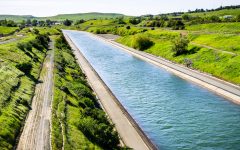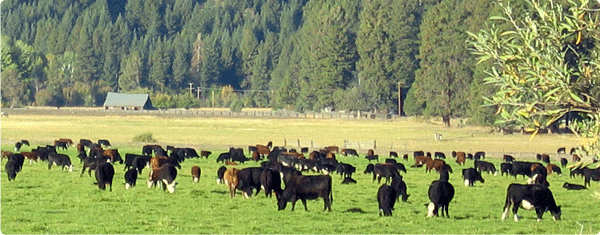
Beautiful California Agriculture. (Photo: Katy Grimes for California Globe)
The Value of a Safe, Affordable and Consistent Food Supply
I tend to appreciate food and those who grow it
By Don Wright, June 28, 2024 2:31 pm
For the past few years I’ve been rolling up and down Highway 99 attending ag irrigation related meetings. I’ve heard several opinions about the value of agriculture and I tend to enjoy a good meal now and then, ipso facto, I tend to appreciate food and those who grow it. Mostly I deal with water matters but what about the industry it supports? What is the value of ag to our area and the state? What is the value of having a safe, affordable and consistent food supply to the United States?
There are plenty of estimates about the economic value of agriculture. It strikes me as often being undervalued. When speaking with an official from the Fresno County Ag Commissioners office I was told the prices given in the legally required, annual crop reports are farm gate value. Farm gate value means the worth of milk in the udder, tomatoes on the vine or nuts hanging on a tree. It doesn’t mean a farmer makes a profit.
Most people know, or at least they should know you can own a million dollars’ worth of something but if you can’t utilize it – you might as well have a million dollars in Confederate States’ currency in a trunk in the attic. You can have 1,000 acres of farmland worth a million dollars but if you can only get enough water to farm half of it it’s only worth 500 acres.
An economic multiplier is figured in to account for the economic activity to takes to turn these crops into yogurt or pizza sauce or chocolate covered almonds. And let us not forget, even though there is far less of it than there used be, the fiber grown here is being woven into socks and shirts and tight whites. Someone once told me High on Speed Rail uses an economic multiplier of 17.2. For every dollar spent on high speed rail construction $17.20 of economic activity is generated in the community. Maybe. For our purposes here we’re using a more conservative economic multiplier of three.
Just Five Counties
The San Joaquin Valley is the top ag producer on earth. It stretches 250 miles from Bakersfield in the south to Manteca in the north where it morphs into the Delta. There are more than five counties in the Valley but I chose the five southern most for this example. The latest crop reports were from 2022 (it takes a while to prepare these things). Using the data from Madera, Fresno, Kings, Tulare and Kern Counties’ official Ag Commissioner approved crop reports the totals were, I’d say impressive. More than $29 billion impressive. Using the economic multiplier that’s $87 billion. (Using HSR’s 17.2 that’d be almost half a trillion dollars.)
The reports state the total acreage used to grow the crops is about 5,589,300 or more than 8,700 square miles. Ok, let’s geek out on some journalist math. If you were to spread the billions of economically multiplied dollars evenly over the thousands of South Valley acres that comes to $10 million per square mile or $15,625 per acre. The total population of the Valley according to the US Census Bureau is 2,708,514. If you gave everyone an even slice of the $87 billion pie they’d each get $32,121 per year at the 2022 rate. After state and federal income taxes that’d be about $27,078 maybe. According to the Census Bureau the California median household income is $91,905.
Of course, this is why it’s journalist math. That annual income would only be if each man, woman and child worked in ag at the same payrate and there wasn’t any gas tax or sales tax or state imposed fees such as car registration or business license and such. My point is it sounds like a lot of money and you can use it that way to make a point. My other point is, when you divide it up it doesn’t go far in California and you can use it that way to make a point too.
SGMA
The Sustainable Groundwater Management Act provides for the State Water Resources Control Board to place a hydrologic subbasin in probation if the combined overlying Groundwater Sustainability Agencies can’t write a Groundwater Sustainability Plan that suits the tastes of the Department of Water Resources. If DWR doesn’t like the plan it kicks it to the State Board. If the State Board doesn’t like the plan it places the subbasin on probation. If the subbasin can’t get a GSP the State Board likes within a year of being on probation the State Board can step in and impose its own plan on the subbasin.
Last November the State Board held a hearing in Hanford, part of the Tulare Lake Subbasin. If the subbasin was placed on probation it would be charged $300 per well, required to place meters on wells pumping more than five acre feet annually and fined $40 for every acre foot pumped. And somehow or other the State Board decided the late fee for not paying the fines promptly would be 25-percent per-month. This money is supposed to be used to pay the State Board for its expenses incurred by placing the subbasin on probation.*
According to the Department of Water Resources’ annual SGMA report from 2022 it estimates the Tulare Lake Subbasin pumped 549,066 acre feet of groundwater. Although the exact number of wells pumping more than 500 acre feet per year isn’t known, a reasonable estimate of 2,300 wells was given by a local water professionals. This amounts to an additional cost to landowners in the Tulare Lake Subbasin of $690,000 for existing wells, $9.2 million for meters and $21,962,640 for water pumping fees. That totals $31,852,640 being removed from the local agricultural economy in 2024 should the subbasin go into probation.
Seeing as how 2024 is an election year the pumping fee was slashed in half to $20 per acre foot. That makes the pumping fine $10,981,320 plus the per well and meter costs the annual fine will be $20,871,320. Most of the Tulare Lake Subbasin is located in Kings County. Returning to journalist math – divided evenly that’s $137 for every man, woman and child in Kings County. Imposed by a law being regulated by the staff of a non-elected board. Of course, the costs are not going to be spread evenly. They will land on the backs of farmers. On April 16th of this year the State Board voted to place the Tulare Lake Subbasin on probation.
Other Subbasins
The Kaweah Subbasin is looking at probation with a hearing in Visalia on June 27th from 5:30-8:30pm at Sequoia High School, 1040 North Woodland, Visalia. Almost all, if not all of the Kaweah Subbasin is in Tulare County. DWR estimates there are 3,353 wells. Taking an average from a dry year and a wet year about 616,550 acre feet was pumped. The $300 per well charge is $1,005,900 and the cost of meters at $4,000 per is $13,412,000. The $20 per acre foot pumped is $12,331,000. Altogether that totals $26,748,900 in fines if the State Board places the Kaweah Subbasin in probation.
The Tule Subbasin is also facing a probation hearing. DWR estimates 715,849 acre feet are pumped annually. At $20 per that’s $14,316,980 for pumping. Let’s say there are about the same number of wells as in the Tulare Lake Subbasin that’d be 2,300 at $300 equals $690,000 and at $4,000 per meter that’s $9,200,000. All in all the Tule Subbasin is looking at fines somewhere around $24,206,980 in extra government required costs if placed in probation.
There are other subbasins in the Southern San Joaquin Valley looking at probation. However, just these three: Tulare Lake, Kaweah and Tule Subbasins may have to pay a collective $71,827,200. Remember, I’m using journalist math and state government estimates. You may want to break out your calculator and redo these figures, but I think it’ll be somewhere in the same ballpark.
Probation
At the Hanford hearing last year one man asked the State Board members and staff if they wrote a Groundwater Sustainability Plan why would it be any better than the one submitted by the Groundwater Sustainability Agencies. That’s a good question. The folks at Tulare Lake have spent more than, I believe, $3 million in engineering and attorney costs to write a plan that has never before been written. SGMA doesn’t include any template to write an acceptable Groundwater Sustainability Plan. During the first year of probation if a subbasin can’t get a Groundwater Sustainability Plan across the State Board finish line and the State Board takes over groundwater management how will it know what to do?
Will the State Board decimate the area’s ag based economy? A big part of the goals for a favorable Groundwater Sustainability Plan is to protect domestic wells from going dry. Many of these wells are in so called disadvantaged communities. Part of the State Board’s staff responses include a section on racial equity and environmental justice. Go here to get a little flavor of how that came about. Census data show more than 60 percent of the Valley’s population is Hispanic. Will the State Board ask itself how hamstringing the number one economic engine the disadvantaged communities depend on will help them? “Good we’ve got water in our well but no job to earn the money to pay the power company to run the well.”
That’s a very real scenario. And it doesn’t seem to be one considered by the non-governmental organizations purporting to represent the disadvantaged communities. Many of whom receive grants from the State Board and most of whom have consistently called for placing the subbasins on probation.
The SGMA and the government regulators are assuming domestic well failures are solely due to declining groundwater levels. There is new information coming to light that the number of domestic well failures due to declining groundwater levels has been grossly over counted. Many of these wells have collapsed casings, clogged screens or the useable lifespan has been exceeded. Yet these wells are counted as dry due to overdraft.
Some other questions are raised if the State Board takes on the task of writing its own GSP for the probationary subbasins: Will the State Board use data from the existing Groundwater Sustainability Plans developed by the Groundwater Sustainability Agencies? Will the State Board reimburse or deduct the cost of the data to the GSA stakeholders? Will the State Board develop its own data to write a Groundwater Sustainability Plan? If so is there any universe where anyone believes this can be done as economically as the work performed under the supervision of the GSAs? Seriously, is there a way even the most thrifty, considerate and expert State Board staff can write a better GSP from Sacramento than a the folks who have been living and farming the San Joaquin Valley for generations? Maybe, but I’d have to see it to believe it.
County By County
The following is a list of the five counties that make up the Southern San Joaquin Valley:
Madera County
Year: 2022; Total Ag Value: $1,993,331,000
Top Crop: Almonds, Nuts & Hulls at $570.7 million
Total Acreage Farmed: 725,300
Population: 160,256
Fresno County
Year: 2022; Total Ag Value: $8,095,546,000
Top Crop: Grapes at $1.24 billion
Total Acreage Farmed: 1,880,000 acres
Population: About One Million
Kings County
Year: 2022; Total Ag Value: $2,594,574,000
Top Crop: Milk at $999.8 million
Total Acreage Farmed: 815,688 acres
Population: 152,682
Tulare County
Year: 2022; Total Ag Value: $8,612,450,000
Top Crop: Milk at $2.67 billion
Total Acreage Farmed: 1,602,520 acres
Population: 479,468
Kern County
Year: 2022; Total Ag Value: $7,724,166,300
Top Crop: Grapes at $1.39 billion
Total Acreage Farmed: 565,792
Population: 916,108
Five County Totals
Total crop value: $29,021,157,300
Total acreage: 5,589,300
Total population: 2,708,514
DISCLAIMER OF RESPONSIBILITY; Waterwrights.net strives to provide its clients with the most complete, up-to-date, and accurate information available. Nevertheless, Waterwrights.net does not serve as a guarantor of the accuracy or completeness of the information provided, and specifically disclaims any and all responsibility for information that is not accurate, up-to-date, or complete. Waterwrights.net’s clients therefore rely on the accuracy, completeness and timeliness of information from Waterwrights.net entirely at their own risk. The opinions expressed in this report are those of the author and do not represent any advertisers or third parties.
*Many years ago I covered downtown Fresno redevelopment. At the time there were folks who really wanted a new baseball stadium. Someone came up with the idea of installing more parking meters to help raise funds. It turned out the cost of installing and maintaining the meters was almost covered by the revenue the new meters generated. Could a government agency find more ways to spend more money from fines to justify more fines so it could spend more money?
ALL RIGHTS RESERVED. Copyright © 2024 by WaterWrights.net
- Jottings: California State Assembly Water, Parks & Wildlife Committee 4/29/2025 - April 30, 2025
- State Water Board’s Reckless Handing of the Sustainable Groundwater Management Act - March 4, 2025
- State Water Board Held Hearing Concerning Placing Kern Subbasin Under Probation, Part I - February 25, 2025





The Democrats in Sacramento had a plan to solve our water problems by simply taking a million acres of the most productive farmland in the world out of production. Probably not the best sign of leadership from our Governor who would be President. A better plan would be to have a group of unelected tools accomplish the same thing. He can’t be blamed for what they do, right. I think there’s been an attempt to manipulate water rights in Idaho to take 500,000 acres out of production. Any chance these are connected?
It seems like the major goal is revenue from fees and penalties, not conserving water. Can you share where and how these funds are being used? NO FARMERS=NO FOOD=NO LIFE!